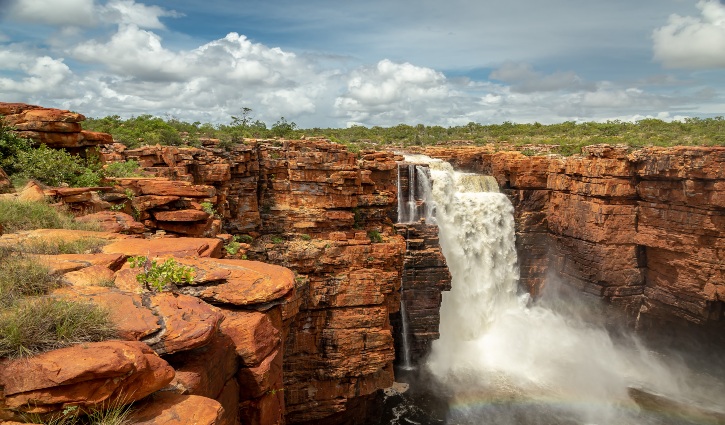
Kimberley Explorer11 Days
STYLE: LUXURY
Embark on a thrilling in-depth exploration of Australia’s world-famous Kimberley Coast, one of the world’s most pristine and untouched wildernesses. Forged by nature and spanning more than 400,000 square kilometres, Western Australia’s wild and remote coastline marries a treasure trove of towering, fractured iron-tinged red cliffs, torrential waterfalls, azure waters, hidden coves and caves, secluded white sand beaches, magnificent reefs and rare and endangered wildlife with indigenous customs and connections to an ancient land, and rich history.
ITINERARY SUMMARY
Note: some voyages operate in reverse.

DAY 1 DARWIN
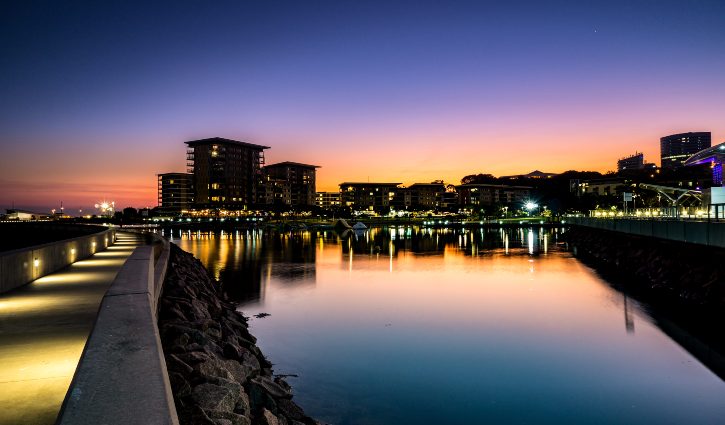
Join Heritage Adventurer this afternoon at Darwin Port, Australia’s ‘northern gateway’ famous for its glittering harbour, World War II history and enviable tropical outdoor lifestyle. The captain and expedition team will be waiting to greet you on arrival and show you to your cabin. You will have time to settle in and familiarise yourself with the ship; you will also be introduced to your expedition team and voyage plans. You are invited to join the expedition team in the Observation Lounge and up on the Observation Deck as you set sail for the Kimberley.
DAY 2 KING GEORGE RIVER
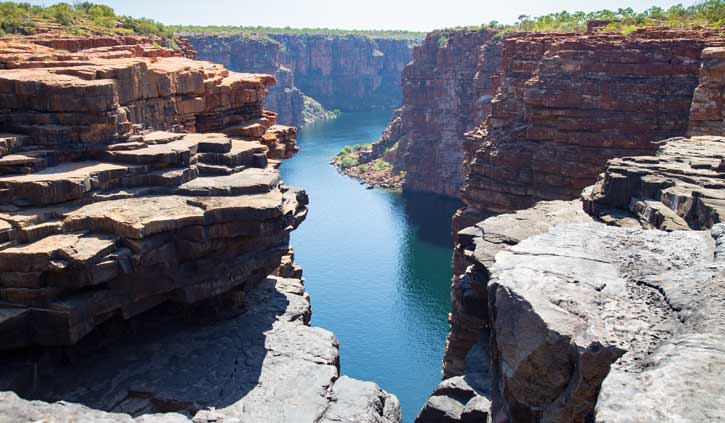
The approach to King George River gorge is not to be missed and best experienced out on the Observation Deck as the towering 2,000 million-year-old Warton sandstone cliffs dwarf our vessel. Navigating this scenic stretch of water by Zodiac, there’s much to take in, passing the ever-changing eroded rockfaces as you cruise deeper into the gorge, marvelling at the untouched beauty of this iconic waterway. As you reach the end of the gorge, nothing will prepare you for the grand scale spectacle of the Kimberley’s highest single-drop falls as the King George River plummets 80 metres over the edge of towering of ancient red sandstone cliffs into tidal waters. Undoubtedly one of Australia’s most awe-inspiring natural wonders, the twin falls known as male and female Rainbow Serpents (or Wunkurr by the Balanggarra people), are fed by wet season rains and rightly hold a special place in indigenous lore. While here, you will learn about how this natural wonder was created and enjoy a closer look.
DAY 3 VANSITTART BAY
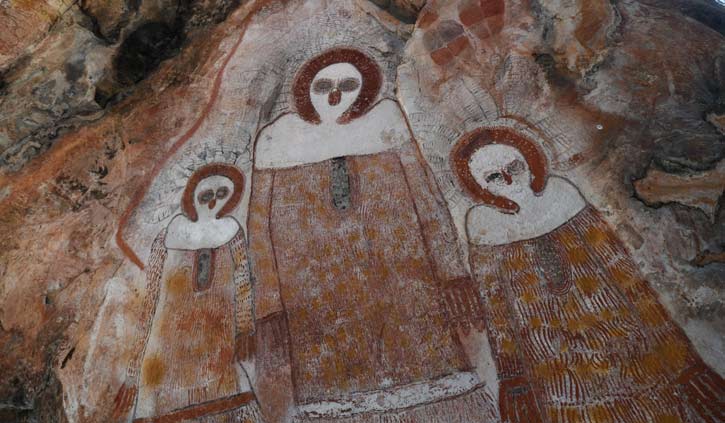
Beautiful islands, pristine white beaches lapped by turquoise waters, secluded coves and stunning scenery abound in Vansittart Bay which is also the location of a historical World War II site and incredible ancient Aboriginal rock art. Named after the Chancellor of Exchequer by early explorer Rear Admiral Philip Parker King, this striking, naturally protected bay is framed by scattered jagged sandstone monoliths and the final resting place of the preserved skeleton of a WWII Douglas C-53 Skytrooper (DC-3) which crash landed onto the saltpan after running out of fuel during a mercy mission to evacuate four Dutch citizens from Java. On Jar Island, the location of ancient outdoor Aboriginal Gwion Gwion art galleries set among fascinating caves and rock formations, much of the rock art tucked under ledges and featured on cave walls is estimated to be up to 40,000 years old and remarkably preserved, protected from the elements. The island is also home to some interesting flora and fauna including the Golden-backed Tree Rat, echidnas and birdlife. Discover a bounty of anthropological and historical wonders in Vansittart Bay.
DAY 4 ASHMORE REEF

Closer to Indonesia than mainland Australia, Ashmore Reef is Australia’s most remote marine park. Its three tropical islands are surrounded by coral reefs and home to more than 500 species of fish, 225 reef-building coral species and 100,000 nesting sea birds. A designated important bird area (IBA) and mostly Sanctuary Zoned, access to Ashmore Reef is strictly controlled. Your visit is in compliance with Australian Government regulations, however there may be an opportunity for a Zodiac cruise near West Island.
DAY 5 BIGGE ISLAND AND CAREENING BAY

Today you will explore the sites of ancient Aboriginal rock art on Bigge Island and the historic Mermaid Boab Tree, which bears the name of the HMC Mermaid which was famously carved into it while the ship was beached there undergoing emergency repairs during Philip Parker King’s third voyage of discovery of the region in 1820. Now measuring some 3 metres wide and National Heritage listed, the tree offers a glimpse into Australian colonial history, while an old Makassan Islamic prayer alcove can be found behind the tree. While here, you will also explore the jaw-slackening, otherworldly sandstone coastline of York Sound with its incredible sea caves and fascinating wildlife.
DAY 6 SWIFT BAY
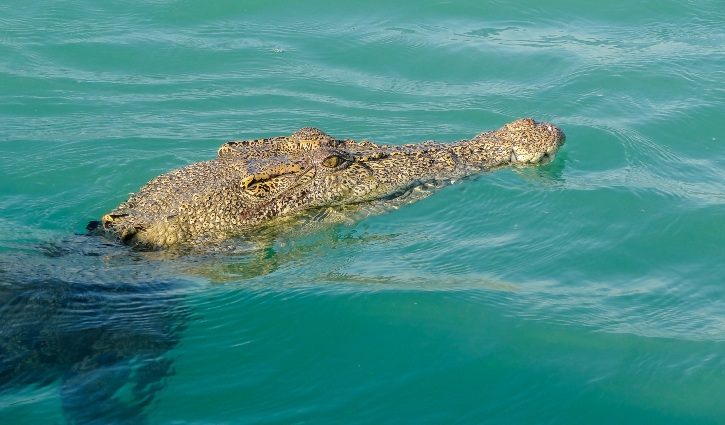
Your intrepid Kimberley voyage sees you today navigating the scattered islands, known as the Bonaparte Archipelago, which stretching almost 150 kilometres along the dramatic coastline. Your destination today is the remote and unspoiled inlet of T-shaped Swift Bay with its sandy beaches, ominous sea-worn caves and mangroves. A Zodiac cruise here allows a closer look at this incredible coastline where you will also likely observe salt-water crocodiles. On land a number of rock art galleries display the unique Wandjina and Gwion Gwion styles on a large scale, denoting the region’s cultural importance.
DAY 7 HUNTER RIVER

During your explorations of the Hunter River today it will quickly become apparent why this winding, 30-kilometre stretch of water is widely considered to be one of the highlights of the Kimberley coast. Tucked into the north-east corner of Prince Frederick Harbour, an enormous bay which puts the Kimberley’s epic scale into perspective, this scenic wonderland is dotted with islands and flanked with wildlife-filled mangrove-lined rivers, savanna woodlands and patches of lush monsoon rainforest, courtesy of receiving the lion’s share of the region’s rainfall, and soaring red cliffs. At the river’s mouth the unrestrained grandeur of 200-metre-high sandstone escarpment Kampamantiya keeps silent sentry, welcoming us into this otherworldly realm you will be exploring today. Fed by two 90-metre waterfalls, the Hunter and the Donkin, Hunter River is home to one of the largest and most pristine mangrove systems in the world. Zodiac cruising the coastline could see us spotting diverse wildlife including White-bellied Sea Eagles, Osprey, Great-billed Heron, Eastern Reef Egrets, Red-headed Honeyeater, Blue-spotted Mudskippers, Fiddler Crabs and more, as well as the iconic saltwater crocodile, of which the Hunter River boasts the Kimberley’s largest population. While here you will also explore Naturaliste Island/Wunumpurramarra and its remarkable, 300-metre-long beach strewn with marine snail shells. There is also the opportunity to experience the granduer of the iconic Mitchell Falls on a thrilling scenic heli-flight (optional extra). This is the only way to experience Kimberley’s famous four-tiered falls and includes a landing on the stunning Mitchell Plateau, one of the most scenic and biologically important areas in Australia. Here you will explore this incredible sandstone landscape carved by the Mitchell River.
DAYS 8 – 9 COLLIER BAY
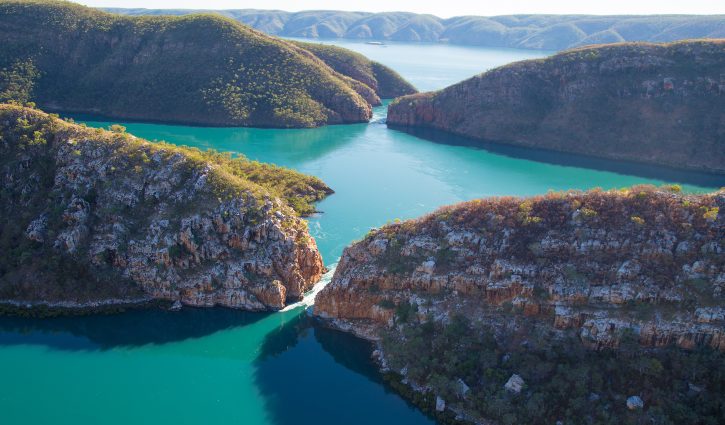
Located at the eastern end of the Buccaneer Archipelago, and only accessible by sea, you have two days to explore the ancient land and sea-scapes of Collier Bay and its astounding natural attractions. At Talbot Bay, you will experience the power of the region’s massive tidal movements which have shaped the landscape, most famously at the world’s only Horizontal Falls. Here we will witness what David Attenborough described as “one of the greatest wonders of the natural world” as trapped water in an inland bay thunders between two narrow chasms as the tide drops more than 14 metres on the other side creating spectacular falls, whirlpools and boiling white water. At nearby Cyclone Creek you will explore the twisted geological folds of the ancient seabed and hope to see the inquisitive Tawny Nurse Sharks among the incredible marine life on display, while another tidal spectacle awaits at Montgomery Reef at the bay’s centre. The world’s largest inshore reef system, we hope to capture the magic of observing this enormous reef ‘rise’ from the ocean as the tide falls creating torrents and waterfalls up to 3-metres high, and displacing marine life igniting a feeding frenzy as predators above and below the water descend. At Freshwater Cove shoreline explorations of the caves and grottos reveal a multitude of ancient rock art galleries.
DAY 10 LACEPEDE ISLANDS
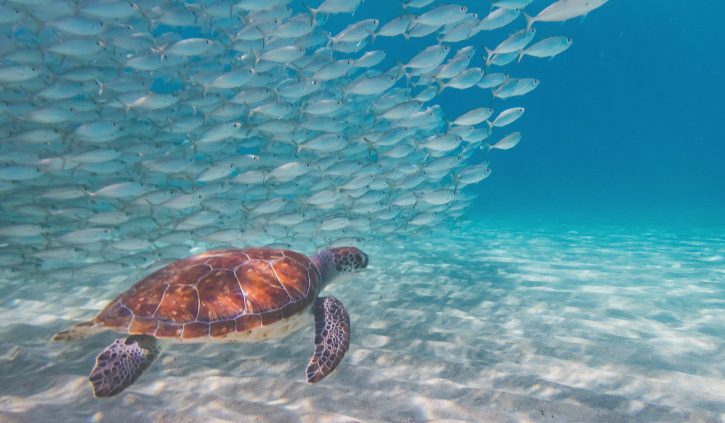
Today you explore the incredible wildlife reserve and birding paradise of the Lacepede Islands. Designated a nature reserve in 1970 and rat free since 1986, this collection of four unassuming islands off the north-west coast of Western Australia are recognised as an Important Bird Area by BirdLife International with what is thought to be the largest breeding colony of Brown Boobies, up to 18,000 pairs, in the world. These small, low-lying spits of coarse sand and coral rubble atop a platform reef are also the state’s most important breeding grounds for Green Turtles. Other wildlife which call these remarkable islands home include Roseate Terns, Masked Boobies, Australian Pelicans, Bridled, Crested and Lesser Crested Terns, Eastern Reef Egrets, Silver Gulls, Common Noddies, Lesser Frigatebirds, and Pied and Sooty Oystercatchers, while Grey-tailed Tattlers, Whimbrels, Bar-Tailed Godwits, Ruddy Turnstones and Great Knots are among the visiting vagrant species. While landings are not permitted, the plan is to explore the islands’ incredible shores by Zodiac and, if lucky, you may also see some Humpback Whales which frequent this coastline during their northern migration in winter and early spring.
DAY 11 BROOME
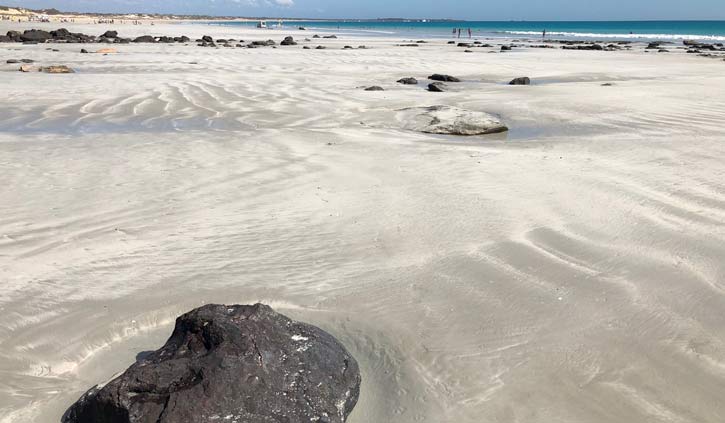
This morning, you will arrive in Broome, a former wild frontier now relaxed tropical beach resort and gateway to the Kimberley. After breakfast there will be a complimentary coach to a central hotel or to Broome International Airport.


